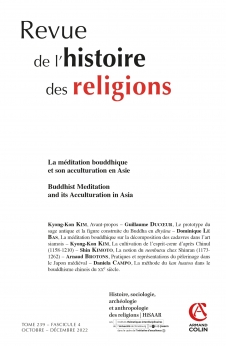
REVUE DE L'HISTOIRE DES RELIGIONS (4/2022)
Pour acheter ce numéro, contactez-nous
Recevez les numéros de l'année en cours et accédez à l'intégralité des articles en ligne.
Le présent article examine les rapports historiques entre les évènements de la vie de Shinran (1173‑1262) et la compréhension du nembutsu qu’il se faisait. Ainsi, la notion du nembutsu qu’il développa est replacée dans le contexte du concept fondamental de l’école Tendai implantée au Japon. À l’époque de Kamakura (1183‑1333), en effet, des moines à la pensée novatrice étudièrent dans cette école bouddhique pour ensuite la quitter. Leur motivation première fut de réaliser la nature de buddha qui, dans cette école, n’était considérée atteignable que théoriquement. Aussi Shinran répondit-il à cette question de l’inatteignabilité de la nature de buddha par une théorie novatrice selon laquelle le nembutsu permettrait à chacun d’accéder, sans condition, à cette même nature de buddha. Pour Shinran, cela signifiait qu’au moyen de la pratique la plus simple, à savoir le nembutsu, la délivrance de tous les êtres vivants pouvait être réalisée selon l’objectif premier de la doctrine bouddhique du mahāyāna.
This paper examines the historical relationship between the events of Shinran’s life (1173‑1262) and his understanding of nembutsu. The understanding of nembutsu that he developed is thus placed in the context of the fundamental concept of the Tendai School established in Japan. During the Kamakura period (1183‑1333), monks with innovative thinking studied in this Buddhist school before leaving it later. Their primary motivation was to realize the Buddha Nature, which in this school was regarded as attainable only theoretically. So Shinran responded to the question of the unattainability of the Buddha Nature with the innovative theory that the practice of nembutsu would enable everyone to attain the Buddha Nature unconditionally. For Shinran, this meant that the deliverance of all living beings could be achieved by means of the simplest practice, namely nembutsu, in accordance with the primary purpose of the Mahāyāna Buddhist doctrine.

